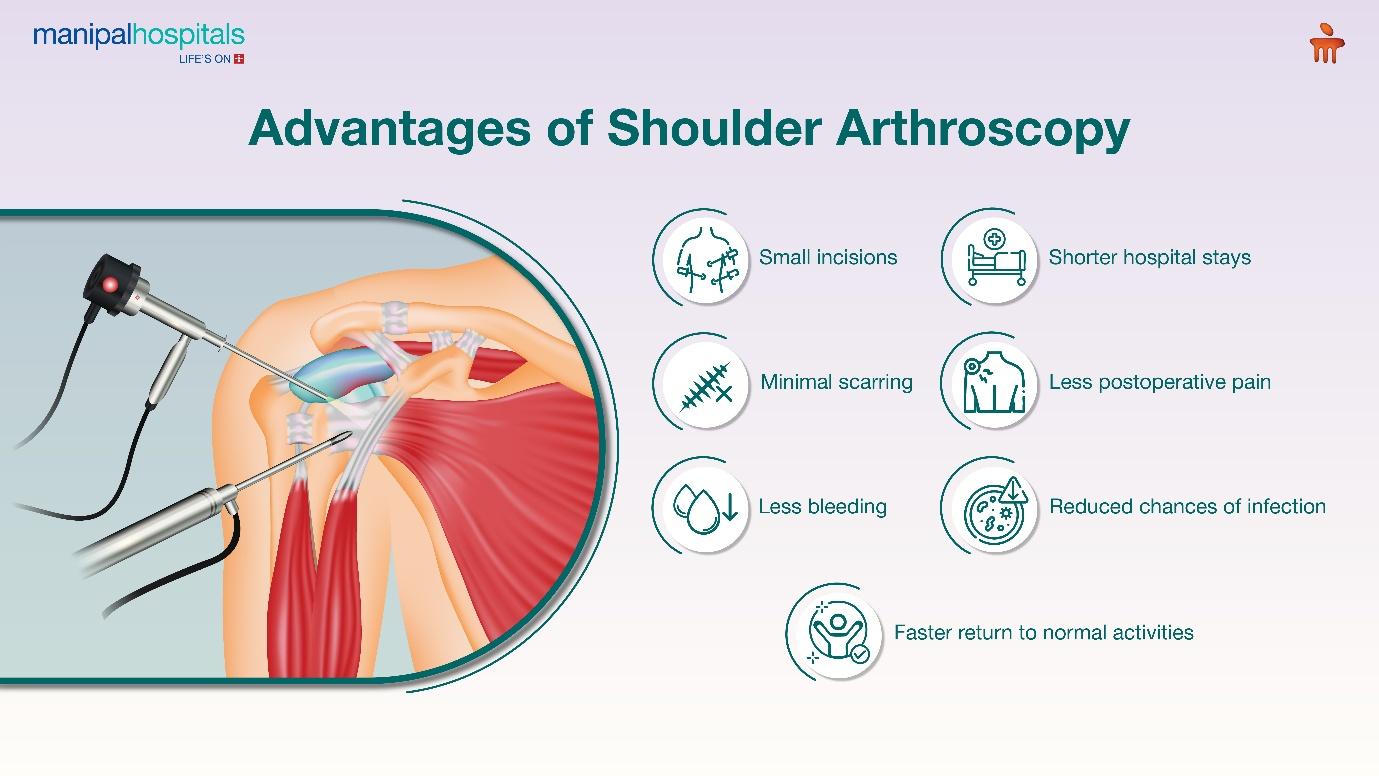
Shoulder problems, whether caused by sports injuries, overuse, or degenerative conditions, can significantly affect a person’s quality of life. Fortunately, medical advancements like shoulder arthroscopy now allow orthopaedic specialists to treat many of these issues with minimal trauma and quicker recovery.
‘Shoulder Arthroscopy’ is a minimally invasive surgical procedure that allows orthopaedic shoulder surgeons to examine, diagnose, and treat problems inside the shoulder joint using a small camera and instruments. It is a frequently performed orthopaedic procedure today, providing excellent outcomes for a variety of shoulder disorders.
Let us understand what shoulder arthroscopy is, when it is recommended, how it is performed, and what recovery looks like.
Synopsis
How is Shoulder Arthroscopy performed?
In shoulder arthroscopy, a pencil-thin device called an arthroscope is inserted into the shoulder joint through a small incision. The arthroscope transmits live images of the joint’s interior to a video monitor for real-time viewing. Additional small incisions are made to introduce instruments used to treat the condition, such as removing inflamed tissue, repairing torn tendons or ligaments, or trimming bone spurs.
Because the incisions are small, shoulder arthroscopy causes less damage to the surrounding soft tissues compared to open surgery. As a result, patients experience less postoperative pain, smaller scars, shorter hospital stays, and quicker recovery.

Conditions Treated with Shoulder Arthroscopy
This versatile technique can be used to treat a wide range of shoulder problems, including:
-
Rotator cuff tears
-
Labral tears (e.g., SLAP lesions)
-
Shoulder impingement syndrome
-
Recurrent shoulder dislocation or instability
-
Adhesive capsulitis (frozen shoulder)
-
Bone spurs or loose bodies in the joint
-
Arthritis and cartilage damage
-
Tendinitis or bursitis
Shoulder Arthroscopy is often recommended when nonsurgical treatments like physiotherapy, medications, and injections fail to provide relief.
Importance of Shoulder Arthroscopy Portals
A critical component of the procedure is the creation of Shoulder Arthroscopy Portals. These are tiny incisions that act as entry points for the arthroscope and instruments. The correct placement of these portals determines the surgeon’s ability to navigate the joint effectively and safely.
Commonly used portals include:
-
Posterior portal: Typically, the initial entry point, used for visualisation.
-
Anterior portal: Provides access to the front of the joint.
-
Lateral portal: Used to approach the subacromial space or rotator cuff.
-
Accessory portals: Such as anterolateral or posterolateral, depending on the specific area being treated.
Accurate portal placement is key to surgical success and helps reduce the risk of complications. Surgeons are trained to adjust portal placement based on individual anatomy and the type of pathology.
Shoulder Arthroscopy Procedure and Recovery
During the Procedure:
Shoulder arthroscopy is usually performed under general or regional anaesthesia. The procedure may take 30 to 120 minutes, depending on the complexity of the condition.
Post Procedure:
Recovery after Procedure:
-
Shoulder Immobilisation: After surgery, the shoulder is often placed in a sling to immobilise and protect the joint during the initial healing phase.
-
Early Passive Movements: Gentle passive exercises are usually started soon after surgery to maintain joint flexibility and prevent stiffness.
-
Physical Therapy Is Crucial: A structured physical therapy program follows, focusing on gradually strengthening the shoulder and restoring full function.
-
Return to Daily Activities: Most patients can resume light daily tasks within a few weeks, depending on the type of surgery performed.
-
Longer Recovery for Rotator Cuff Repair: Complete recovery—especially in cases of rotator cuff repair—can take several months, requiring consistent rehab and patience.
-
Managing Postoperative Symptoms: Pain, swelling, and stiffness are common but typically subside over time with medication, ice therapy, and regular rehabilitation.
Why is arthroscopy preferred over open shoulder surgery?
The key advantages of shoulder arthroscopy include:
-
Small incisions and minimal scarring
-
Shorter hospital stays or day-care procedures
-
Lower risk of infection and blood loss
-
Less pain after surgery
-
Quicker return to daily routines
-
Effective results with experienced surgeons
Whether it is treating a sports injury or managing degenerative shoulder disease, Shoulder Arthroscopy has become a trusted and effective option worldwide.
Conclusion
Shoulder arthroscopy is a safe, effective, and minimally invasive technique that has transformed the management of shoulder joint problems. With the use of strategically placed shoulder arthroscopy portals, surgeons can precisely address complex shoulder conditions.
If you are experiencing persistent shoulder pain or limited movement that has not improved with non-surgical treatment, consult an orthopaedic shoulder specialist at Manipal Hospital Salt Lake. Shoulder Arthroscopy may be the key to restoring mobility and getting back to the activities you love, without the burden of open surgery.
FAQ's
One may feel some discomfort after the surgery, but it is usually less when compared to an open surgery. The pain can be managed with medications, rest, and physiotherapy.
In most cases, the procedure takes 30–120 minutes, depending on the complexity and the condition being treated.
Recovery may take 2–6 weeks, but complete recovery—especially after tendon repair—can take 4–6 months or more with rehabilitation.
Like any other surgery, risks include infection, bleeding, nerve injury, stiffness, or pain, though serious complications are rare.
Desk jobs can be resumed in 1-2 weeks, but manual work may take 6-12 weeks.





















 5 Min Read
5 Min Read





















